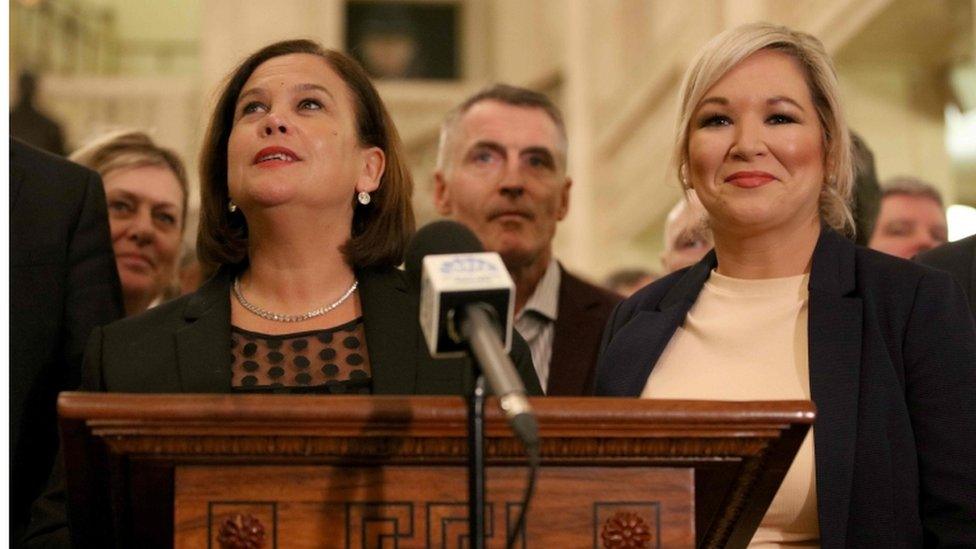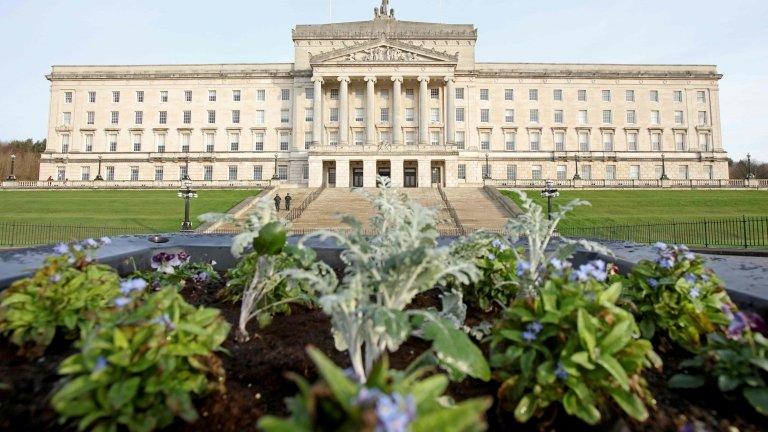Stormont: How the parties got a deal done
- Published

The deal does not appear to give Sinn Féin the standalone Irish language act
For three years, nothing. Then suddenly, it all happened at once.
Some might wonder why, after all that time, it seemed to come together so quickly. But it is worth remembering that there were at least three serious rounds of negotiations, too many missed deadlines and an awful lot of late-night rewrites to get to this moment.
The Northern Ireland Secretary Julian Smith described it as the "moment of truth" for the parties: it has become the moment many across Northern Ireland had been waiting for.
But why now have the DUP and Sinn Féin agreed to put aside their differences and go back into government together?
Split this into two parts: what they've secured in the deal, and the wider political context of 2020.
The deal does not appear to give Sinn Féin the standalone Irish language act they once demanded as a pre-condition for restoring devolution, which became the key sticking point in subsequent talks.
But it does, as Irish language campaigners have pointed out, mark a historic step as for the first time Irish will be given legal status in Northern Ireland.
While some unionists might balk at that, the DUP in turn secured similar legislation for Ulster-Scots, seen as important to many in that community.
Both sides are selling the plans as a win.

The DUP and Sinn Féin are selling the plans as a win
It helps that the British government has promised to hand over a lot of money alongside the deal - though how much exactly, has yet to be disclosed.
Then take circumstances surrounding Friday night's events.
As of last month, the DUP lost its influence in Westminster after Boris Johnson's general election victory brought an end to the confidence-and-supply pact his party had shared with the DUP for two years.
In that same general election, both the DUP and Sinn Féin saw their vote share drop while Alliance and the SDLP reaped success.
The road back to Stormont
Three years of stalemate, indecision and a slow decay of public services in Northern Ireland was being rejected by many voters.
Add in strikes calling for pay parity for Northern Ireland's health workers with those in Great Britain and rocketing waiting lists - it began to look like all roads, finally, had to lead back to Stormont.
Following a week of negotiations at the turn of the new year, the endgame began.
The two governments were taking a gamble by not only settling on a final text, but publishing it for all to see.

The SDLP, UUP and Alliance previously took seats in the decision-making executive
They even framed the title of the deal on newness - a "new decade, new approach".
They've got the deal over the line now, and many will credit Julian Smith's no-nonsense approach for delivering the goods.
What happens now Stormont is coming back?
The deal contains promises and commitments that this time, power sharing will be different.
For almost 10 years, the DUP and Sinn Féin managed to work together, with the SDLP, UUP and Alliance all taking seats in the decision-making executive too.
But in 2016, those smaller parties chose to go into opposition which saw the DUP and Sinn Féin themselves alone - with independent unionist Claire Sugden filling the Justice brief.
The content of this deal means the SDLP has already decided to take up its place in the executive again.
The other parties may follow suit too.
But promises and pledges are easy to make, and in Northern Ireland, the ups and downs of devolution - and its collapses - are well rehearsed.
Time will tell if this really is a new decade with a new approach.
- Published10 January 2020

- Published10 January 2020
